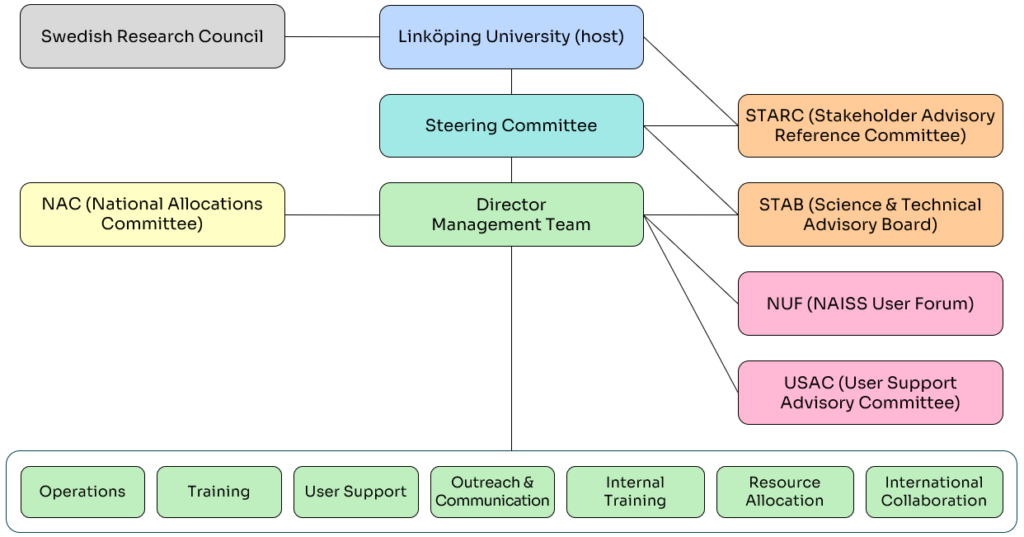About us
(För information om NAISS på svenska se denna sida.)
The National Academic Infrastructure for Supercomputing in Sweden (NAISS) maintains advanced computing, artificial intelligence, and data services that support research ranging from fundamental research in mathematics or physics to climate modelling, the green transition, life science and economics. NAISS is hosted by Linköping University, with funding provided by the Swedish Research Council (Vetenskapsrådet) for the years 2023-2026 under contract 2022-06725.
NAISS is the largest and most widely used research infrastructure in Sweden, involving more than 7,600 users at some 30 universities and research institutes (statistics from 2023). We also maintain special dedicated resources for infrastructures, agencies, and external users.
We aim to evolve with our users and their needs. NAISS should be your partner from the first time you open an account on a cluster and need Linux training to the point where you manage a team running a state-of-the-art simulation or AI training on 10,000 GPUs.
A diverse portfolio of computing infrastructure
The main resources provided by NAISS and collaborating organisations include
- High-performance computing clusters/supercomputers consisting of nodes with high-end CPUs or GPUs and large amounts of memory, where thousands of such nodes are connected by very fast networks.
- Large storage to handle extreme data sets.
- Sensitive data storage and computing services.
- AI-focused resources equipped with GPUs that have large amounts of memory to enable training of, for instance, large language models, coupled to fast storage.
- Cloud resources that enable interactive usage for instance in Jupyter notebooks, and in the future AI inference workloads.
- Training in the form of classes, workshops, hackathons, and documentation.
- Support ranging from simple helpdesk queries to long-term research software engineering development funded by university partners and others.
NAISS is in the process of establishing a Swedish node in the international EuroHPC Joint Undertaking infrastructure with the new supercomputer Arrhenius, which is scheduled to come online late 2025. This will enable a significant expansion of resources from 2026, tighter integration and better support of the various services offered. The infrastructure will also expand training and support offerings and improve access to international resources, both hardware and training.
Access and support
All NAISS resource allocations are based on proposals. Getting started with a small allocation only requires a brief description of your needs in the SUPR user portal, and we will typically get back to you within days. Medium and large-scale proposals undergo more extensive review, as described under Allocations, where you can also find information about the National Allocation Committee (NAC). Computing and storage resources are typically scarce, and the prioritisation is based on scientific excellence and the expected impact.
Thanks to additional funding by our partner universities, NAISS is providing nationwide support through local staff at branches across Sweden, ensuring access to a range of different competences. Open house events will be organised at all these sites. In cases where the competence you need is not available locally, NAISS support staff will connect you with suitable experts at other sites. In some cases, local NAISS staff is physically co-located at a local computing center.
Governance
Major decisions in NAISS are taken by the Steering Committee, which is appointed by Linköping University Vice-Chancellor Jan-Ingvar Jönsson. Professor Jan-Eric Sundgren. The main executive officer of NAISS is the Director, Erik Lindahl, joined by Anna Jänis as head of administration and a management team including associate directors as described on the Staff page.

NAISS has continuous strategic discussions with the Swedish Research Council about how to best serve the needs of users. This is reflected in documents such as the overall strategic plan as well as annual activity plans and activity reports. There are also annual meetings with the Stakeholder Advisory Reference Committee (STARC), where partners providing co-funding to the infrastructure are represented to have dialogues about priorities and needs, in particular with regard to distributed support. For strategic prioritisation involving scientific computing or infrastructure operations, the director and steering committee are aided by the NAISS international Science & Technology Advisory Board (STAB).
In addition to the National Allocation Committee (NAC) evaluating proposals, users are strongly encouraged to take part in the annual NAISS User Forum that is organised at partner sites to discuss news, needs and general development. The User Forum also nominates representatives to the User Support Advisory Committee (USAC), which provides advice and suggestions to the director and management team based on their scientific expertise and experience from using NAISS resources.
These are our current 12 partners:
- Chalmers University of Technology
- Karolinska Institutet
- Linköping University
- Linnaeus University
- Luleå University of Technology
- Lund University
- Royal Institute of Technology / KTH
- Stockholm University
- Swedish University of Agricultural Sciences
- Umeå University
- University of Gothenburg
- Uppsala University